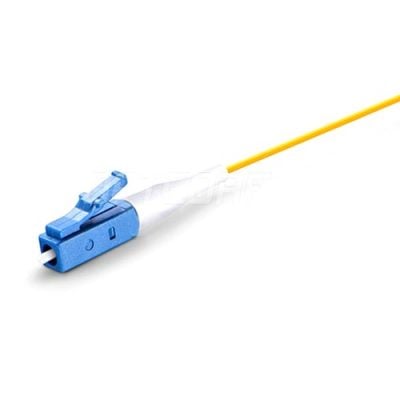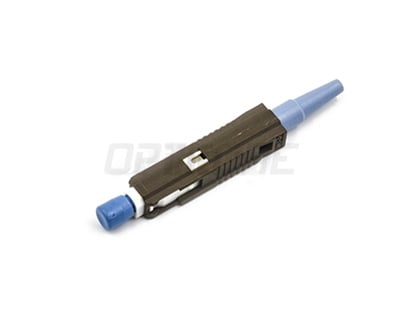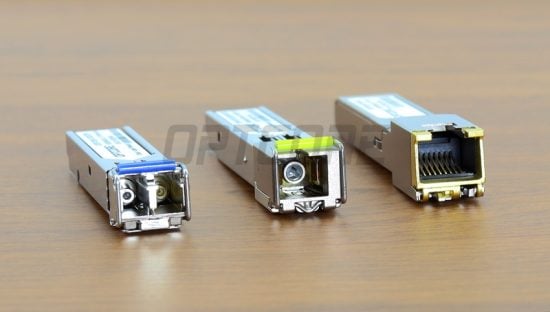Blog, Optical Networking
LC vs SC vs MU Connectors: What is the Difference?
In the previous blog post, we provided a comprehensive guide to the types of fiber optic connectors. However, many professionals and operators still are confused about the main types of fiber optic connectors. Today, I’d like to compare the differences between LC vs SC vs MU connectors. The comparison will help you choose which is better for you.
Table of contents
LC vs SC vs MU: What is LC Connector
Let us compare this LC vs. SC vs. MU connector with a basic overview of the three fiber optic connectors. The LC connector, whose full name is Lucent Connector, was developed by Lucent Technologies in the early 2000s. It is the most well-known SFF (Small Form Factor) connector in the fiber optic industry.

The LC connector is known for its small size compared to the earlier SC connector. Unlike the SC connector, it is equipped with a 1.25mm ceramic ferrule, nearly half the size of a 2.5mm ferrule. Additionally, the LC connector provides a more compact package, allowing for higher density in the same space. These features have made it very popular since its launch in the market.
The basic LC connector consists mainly of the dust cap, connector housing, ferrule, spring, and boot. TheIt uses a latch-lockingchanism.
LC vs SC vs MU: What is SC Connector
SC’s standard full name is Subscriber Connector. Still, people sometimes call it a standard connector, square connector, or stick-click connector.

Let’s introduce its history. SC was initially developed by Nippon Telegraph and Telephone (NTT) in 1993, so it is now over 30 years old. Since its creation, the SC has rapidly gained market share, becoming a key player in the industry.
Like most fiber optic connectors, the primary SC connector consists of a dust cap, connector housing, inner frame, spring, stopper, and boot. It features a 2.5mm ceramic ferrule to ensure accurate alignment and low insertion loss.
LC vs SC vs MU: What is an MU Connector

The MU connector, which appeared later than the SC connector, was launched in 1997. It stands for miniature unit coupling, which NTT also developed. In fact, it is like the Miniature SC but uses a 1.25mm zirconia ferrule for improved density.
Compared with SC and LC connectors, MU is not a successful fiber connector in the market. Few people know about it, and its applications are limited. The MU connector’s compact size and improved density due to the 1.25mm zirconia ferrule make it suitable for specific applications where space is critical.
However, its lack of widespread adoption and compatibility issues have limited its popularity and practical use compared to the widely accepted LC and SC connectors.
LC vs MU Connector: What Are The Differences?
Once you understand LC and MU, you know that both have many similarities and the same features. But what is the most explicit difference between these two fiber connectors? In this section, we will explain all the differences between these two fiber optic connectors.
| Comparison | SC Connector | LC Connector | MU Connector |
| Ferrule Size | 2.5mm | 1.25mm | 1.25mm |
| Mechanism | Pull-push Mechanism | Latch Locking | Pull-push Mechanism |
| Cost | More Cost-effective | Expensive | Most Expensive |
| Durability | 1000 Mating | 500 Mating | 500 Mating |
| Insertion Loss | 0.25-0.5dB | 0.25-0.5dB | 0.25-0.5dB |
| IEC Specification | IEC 61754-20 | IEC 61754-4 | IEC 61754-6 |
| Published Date | 1993 | 2000 | 1997 |
| Typical Application | General Optical network application: fiber internet and cable TV, Wi-Fi router, Legacy GBIC,XENPAK &1×9 Transceiver | High-density optical network: data centers and server rooms, High-speed transceiver like SFP, SFP+, QSFP, QSFP-DD | Special optical networks like CATV, Data Center,On Board Optics, Medical and Wireless |
| Ease of Use | ••••• | ••••◦ | ••••◦ |
Size
The LC connector is smaller than the MU connector, making it more suitable for high-density (HD) fiber cabling applications with limited space.
Mechanism
The second significant difference is the mechanism and appearance. MU uses a push-pull connector like the SC. However, LC uses latch locking, which is different from them.
Cost
Different manufacturing processes and market popularity result in various costs. In 2022, LC connectors shared around 36.7% of the market; they are the most popular segment. Meanwhile, the MU connectors will be categorized as other segments, and there is no detailed data.
Therefore, LC connectors and patch cables cost much less than the same corresponding MU products. In this cost aspect, LC is the apparent winner.
Variants
MU variants are available in Simplex, duplex-horizontal, and duplex-horizontal-Compact (MU-Compact). LC variants are available in Simplex, Duplex, and Uniboot LC.
Typical Application
The LC is typically suitable for modern high-density optical networks, such as those in data centers, servers, and cloud computing. General products include patch cables, panels, SFP, transceivers, adapters, etc.
The MU is limited to some special optical networks, such as WDM/DWDM systems, MAN and WAN, SAN, and data centers.
LC vs SC Connector: What Are The Differences?
There are many articles on the differences between LC vs SC connectors. So, in this section, we will simply summarize their differences.
Size
Because LC uses a 1.25mm fiber ferrule, while SC uses a 2.5 mm ferrule, the smaller ferrule lets the LC be equipped in a very compact space. That makes it ideal for high-density fiber connectivity with limited space.
In the same application scenario, the end users can deploy 2x fiber cables when using the LC solution to replace the SC fiber solution.
Mechanism
The second significant difference is the mechanism. SC uses a push-pull latching mechanism to lock and unlock the connector, while LC uses a latch locking mechanism.
Cost
LC products used to cost more than SC products. However, with the growing market share and drop in manufacturing costs, LC now costs similar to SC. Therefore, most IT operators don’t need to worry about the cost difference between them; they should just choose the one suitable for their real network needs.
Typical Application
In many cases, LC and SC connectors share very similar applications. However, most modern and flexible fiber networks choose LC-based products, which provide many application choices. As one of the core components of the fiber network, most optical transceivers (SFP/SFP+/QSFP+) use an LC interface instead of SC. That makes LC grab broader actual applications in networks.
LC vs SC SFP: What Are The Differences?
When it comes to the SFP module, some guys may be unfamiliar with the fiber interface. In this section, we will make a simple comparison of LC vs SC SFP transceivers.

Connector
The most critical difference is the fiber connector in the SFP. Usually, the standard SFP only uses the LC female connector (Simplex or duplex one). That is, it follows the multi-source agreement and is the default connector.
LC SFP generally uses a simple or duplex LC interface. SC SFP uses an SC interface but only supports simplex SC connectors. That is because the small-size SFP allows only one SC connector in the fiber interface. Therefore, when we talk about SC SFP, it will default as BiDi transceivers.
Cost
SC SFPs usually cost more than LC SFPs. The most crucial reason may be the market size rather than the manufacturing cost. Therefore, unless you must have an SC interface, we strongly recommend choosing the standard LC SFP transceiver.
LC vs SC vs MU FAQs
Q: Can you convert SC to LC?
A: Yes, you may use the SC-LC patch cables or SC-LC adapters to converter them.
Q: Is SC Connector better than LC?
A: There’s no clear answer to that. You should consider the specific use cases. Choose SC if you need a more durable connector that is easier to handle and is suitable for less dense installations. Choose LC for high-density environments where space is at a premium, higher performance, and faster data transfer speeds are required.
Q: How do you connect LC to SC fiber cable?
A: The quick answer is to use a hybrid LC-SC fiber patch cable or hybrid LC-SC adapter to bridge the two different connector types.
Q: Which type of transceiver uses the SC connector?
A: The SC connector is found in the legacy 1×9, GBIC, SFF, XENPAK, and X2 transceivers.
Q: Which type of transceiver uses the LC connector?
A: Most modern transceivers use default LC female connectors, including SFP, SFP+, XFP, QSFP+, QSFP28, and QSFP-DD.
Conclusion
The comparison between LC, SC, and MU Connectors can be challenging because they share many similar features and characteristics. We trust this comparison will help you choose between them. If you are still trying to figure it out, remember they have no essential difference in optical performance. Outline your specific use case and prefer to choose the more popular connector for flexing upgrade and lower total cabling cost.
Read More:
- Fiber Connector Types: A Complete Guide
- What is SFP Module? An Ultimate Guide
- Fiber Color Code: A Simple Guide for Beginners







